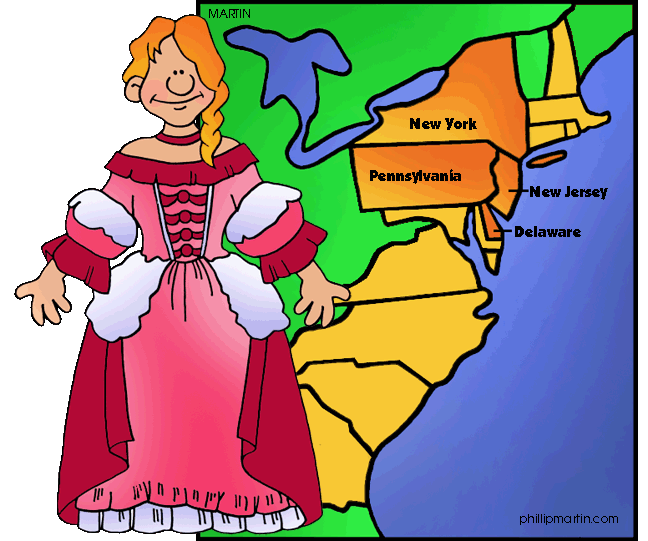The Middle Colonies for Kids: The Breadbasket colonies
The Middle Colonies were composed of what is today the states of New York, Pennsylvania, New Jersey and Delaware.
Because the soil was rich in the Middle colonies, farmers were able to grow more grain than they could use. They began selling grain to other colonies and to England, shipping out of the big ports in Philadelphia and New York. Because of this, the middle colonies became known as the Breadbasket colonies.
The Middle Colonies were more cosmopolitan and tolerant than the New England colonies. A lot of the success of Pennsylvania and Delaware is owed to William Penn. Under his guidance, Philadelphia became a fabulous city, with broad, tree-shaded streets, stone and brick houses, and a bustling port. Manhattan flourished under the Dutch. The Germans were probably the best farmers in the Middle Colonies.
The middle colonies were enriched by the culture of people from all over Europe, including Quakers, Scots, Irish, Dutch, French, Danes, Norwegians, Swedes, and more. Farms flourished and craftsmen established successful businesses. There was a brisk business in trade. Ships docked at the New York harbor in huge numbers, fighting for space to unload. New ships were under construction. Coopers made thousands of barrels for storing cargo. Chandlers were merchants who sold everything needed to stock and repair ships. Ships carried food and timber from the New World to the Caribbean islands and returned with coarse brown sugar. Rum and tobacco shipped to England fetched high prices. There were mills to grind grain, sugar refineries, bakeries and taverns, fine craftsmen getting high prices for beautiful goods. Merchants became rich.
There was a dark side to all of this. Some ships returned with slaves. Caribbean and African slaves were traded on ships in the harbor. Smugglers unloaded goods from the ships at night to avoid paying the import tax, which limited monies towns and cities could spend on keeping the streets clean and safe. At night, thieves roamed the unlit streets, targeting anyone really, but especially fashionable English gentlemen in showy outfits.
Still, port towns continued to boom with trade. By the 1700s, cities were divided into wealthy merchants and poor and enslaved workers, and life for many had moved from pleasant to tense.

